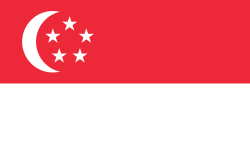Colony of Singapore (1946–1959) State of Singapore (1959–1963) | |
|---|---|
| 1946–1963 | |
| Motto: Dieu et mon droit (French) (1946–1959) (English: "God and my right") Majulah Singapura (Malay) (1959–1963) (English: "Onward Singapore") | |
| Anthem: "God Save the King" (1946–1952) "God Save the Queen" (1952–1959) [note 1] "Majulah Singapura" (1959–1963) (English: "Onward Singapore") | |
 Location of Singapore | |
| Status | Crown colony (1946–1959) Self-governing colony (1959–1963) |
| Capital | City of Singapore 1°18′N103°51′E / 1.30°N 103.85°E |
| Official language and national language | English |
| Common languages | |
| Government | Constitutional monarchy |
| Monarch | |
• 1946–1952 | George VI |
• 1952–1963 | Elizabeth II |
| Governor [1] | |
• 1946–1952 | Sir Franklin Gimson |
• 1952–1955 | Sir John Fearns Nicoll |
• 1955–1957 | Sir Robert Black |
• 1957–1959 | Sir William Goode |
• 1959–1963 | Yusof Ishak |
| Chief Minister [2] | |
• 1955–1956 | David Marshall |
• 1956–1959 | Lim Yew Hock |
• 1959–1963 | Lee Kuan Yew |
| Legislature | Legislative Council (1946–1955) Legislative Assembly (1955–1963) |
| Historical era | British Empire · Cold War |
• Dissolution of the Straits Settlements | 1 April 1946 |
| 15 July 1946 | |
• The Colony of Singapore being conferred city status by King George VI | 1951 |
| 23 November 1955 | |
| 1 October 1958 | |
• Autonomy within the British Empire | 1959 |
• Merger with the Federation of Malaysia | 16 September 1963 |
| Currency |
|
| Time zone | UTC+07:30 (Malaya Standard Time) |
| Date format | dd-mm-yyyy |
| Today part of | Singapore Australia Malaysia |
Notes
| |
| History of Singapore |
|---|
 |
The Colony of Singapore was a Crown colony of the United Kingdom that encompassed what is modern-day Singapore from 1946 to 1959. During this period, Christmas Island, the Cocos (Keeling) Islands, and Labuan were also administered from Singapore. Singapore had previously been established as a British colony since 1824, and had been governed as part of the Straits Settlements since 1826. The colony was created when the Straits Settlements was dissolved shortly after the Japanese occupation of Singapore ended in 1945. The power of the British Government was vested in the governor of Singapore. The colony eventually gained partial internal self-governance in 1955, [2] and lasted until the establishment of the State of Singapore in 1958, with full internal self-governance granted in 1959. [3] [4]
Contents
- History
- Post war period: Return of British rule
- From colony to state
- Merger with Malaysia
- Independence
- Government
- First Legislative Council (1948–1951)
- Second Legislative Council (1951–1955)
- Administration
- Governors of Singapore (1946–1959)
- Notes
- References
After a few years of self-governance, Singapore went on to merge with Malaya, Sarawak and North Borneo (Sabah) to form Malaysia on 16 September 1963, thereby completely ending 144 years of British rule in Singapore. Due to differing views in dealing with political, economic and racial issues, Singapore would eventually cease to be a part of Malaysia and become an independent sovereign country on 9 August 1965.









